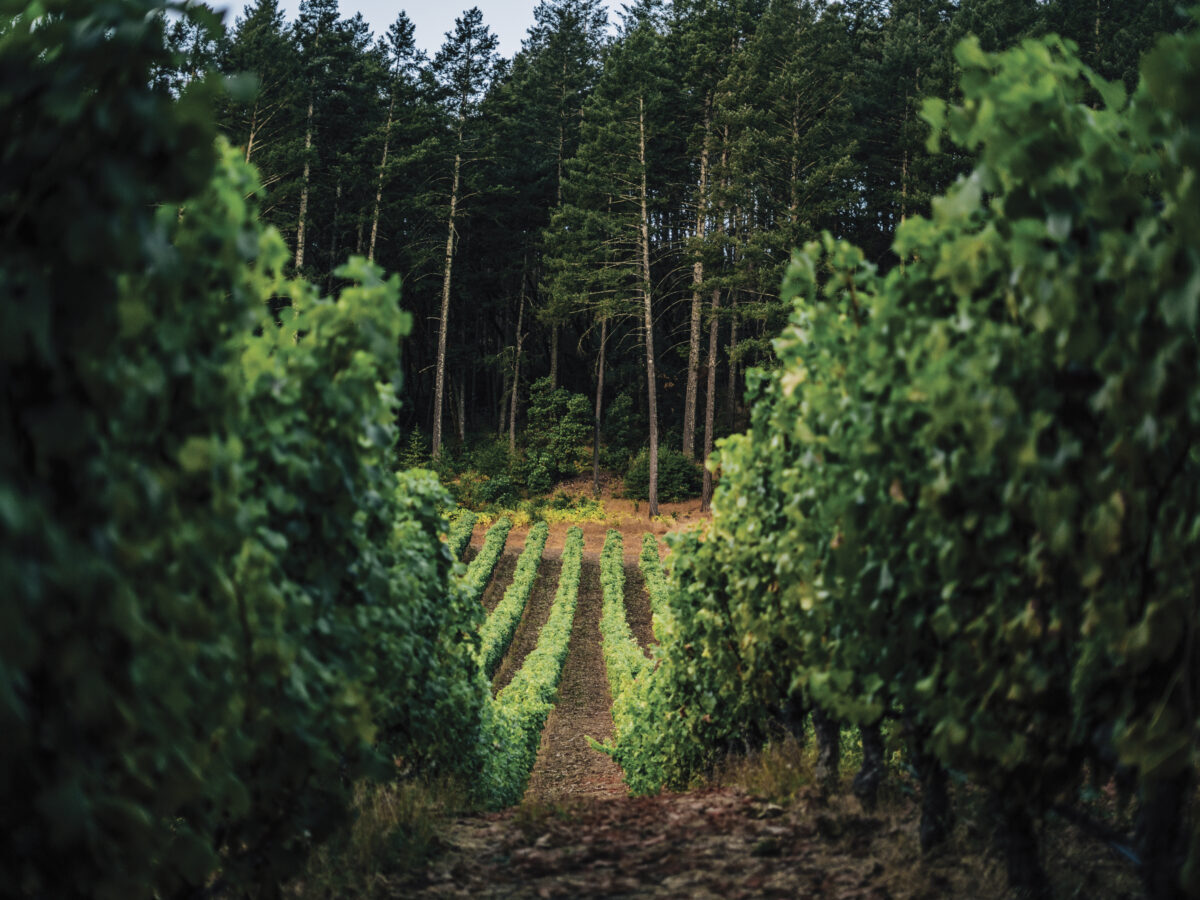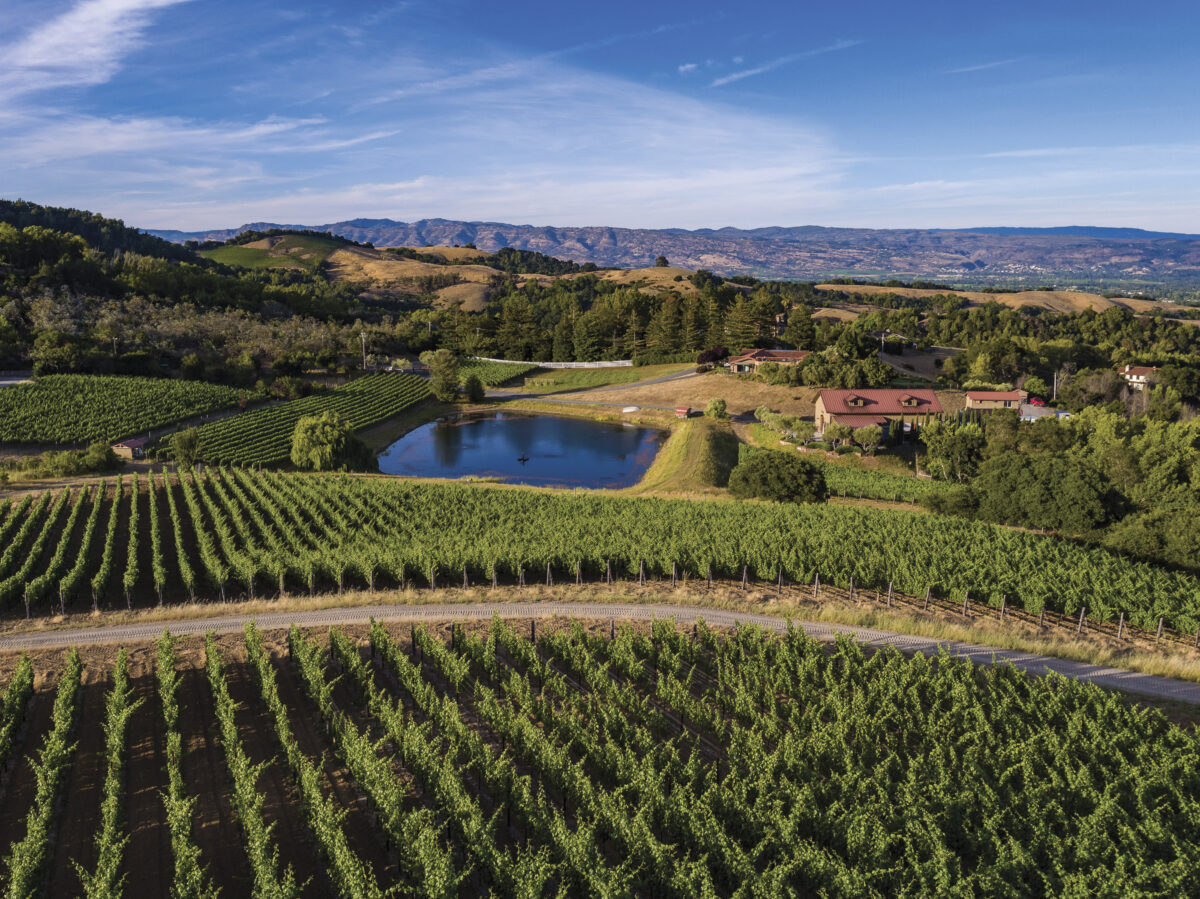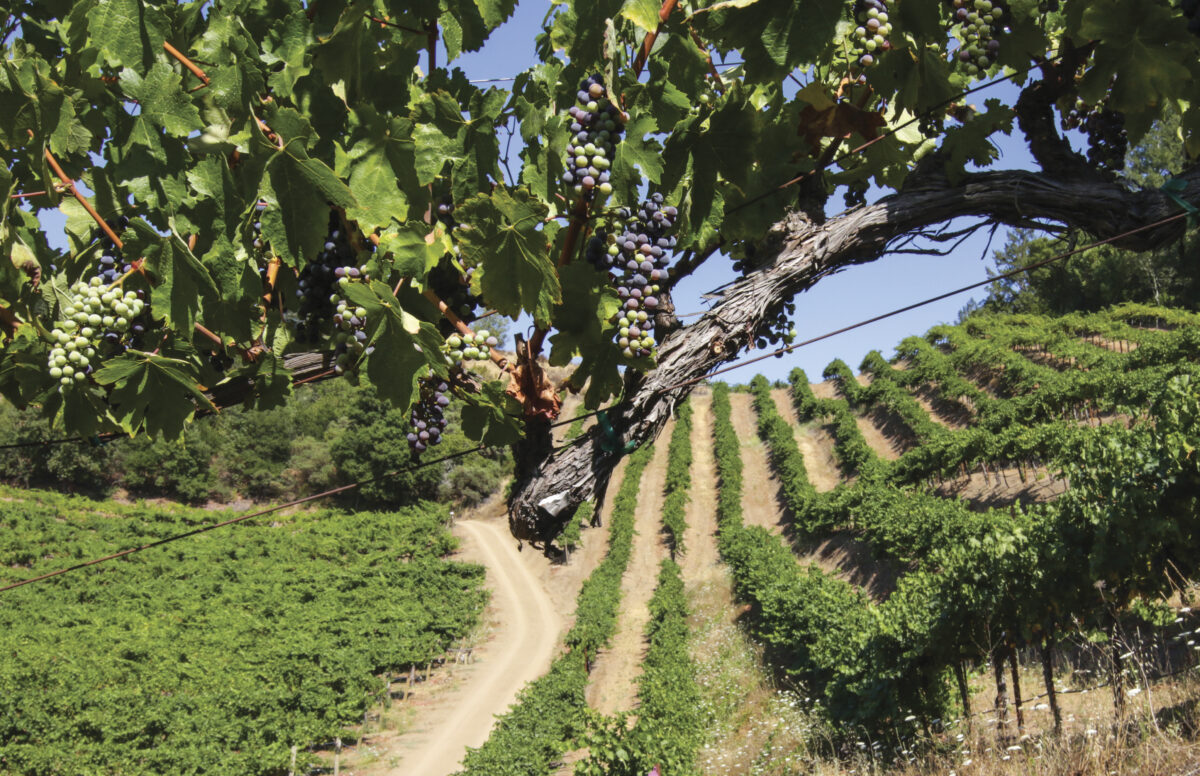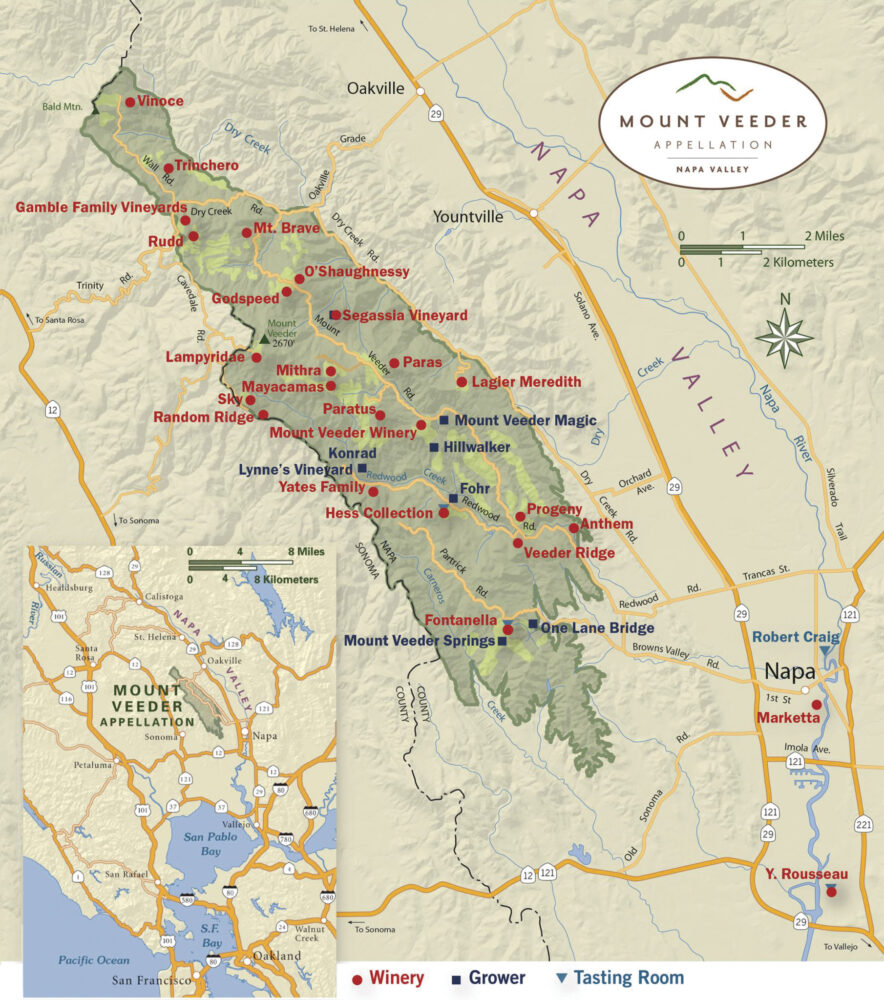home featured + SIP
Mt. Veeder
Bottling Distinction from Rugged Terrain
WRITTEN BY Melissa Vogt
|
Published On: June 06, 2024

Photo above courtesy of Rudd Vineyards
In a region filled with endless views of sprawling valley-floor vines, it may come as a wonder that any producer in Napa Valley takes to the rugged terrain of the mountains for growing grapes. But for many producers, the steep slopes of the mountainous appellations in Napa Valley offer sought-after terroir and microclimates that can’t be found on the valley floor—what those on Mt. Veeder believe to be the ideal growing conditions for Cabernet Sauvignon and Sauvignon Blanc.
In the Mt. Veeder appellation, winegrowers and winemakers are working with the same varietals as those on the valley floor, but the distinct terroir gives wines from the region specific characteristics that distinguish them greatly from valley-floor styles.

Photo courtesy of Fontanella Vineyards
Terroir & Terrain
Mt. Veeder is situated on Napa Valley’s western mountain range, the Mayacamas, and the AVA is adjoined by the Los Carneros AVA on its southern end. Its highest vineyards are planted at an impressive 2,400 feet, and the soils are comprised of ancient, pushed-up seabed. With its relative proximity to the San Pablo Bay to the south, coupled with high elevation, Mt. Veeder is one of the cooler AVAs in Napa Valley. These conditions force a longer, slower growing season and offer much smaller harvest yields than their valley-floor counterparts. “Sometimes good things do come in small packages,” said Jeff Fontanella of Fontanella Family Winery. While lower yields mean smaller production and often higher pricing, these coveted wines offer deep concentration from the gradual ripening. According to Karen Crouse, Grower/Vintner of Mt. Veeder Magic Vineyards, “Only 1% of Napa Valley’s wines come from the Mount Veeder AVA. The rugged conditions throughout the AVA require that all farming be done by hand. This is an incredible quality control.” At Mt. Veeder Magic Vineyards, Crouse’s vines are over 40 years old, and her hillside vineyard’s steep slopes render shallow topsoil and allow minimal water retention, yielding tiny, concentrated fruit. “The resulting Bordeaux-style Cabernet Sauvignon is balanced with depth and concentration yet soft tannins,” Crouse said.
Julie Arbuckle, proprietor of Anthem Winery & Vineyards, agreed. “Mt. Veeder’s hillside vineyards produce smaller berries full of intense, concentrated flavors that produce some of the most beautiful Cabernets in the world,” she said. “Well-drained soils and great sun exposure combine to make dark and complex Cabernet,” furthered Eric Stauffer, winemaker at VGS Chateau Potelle. Cabernet Sauvignons from Mt. Veeder reveal complexity in their aromas and flavors, combining rocky, soil-like elements, chocolate and espresso notes, and myriad fruits.
While elevation certainly contributes to depth and structure, forest flora also adds its own nuance. On Mt. Veeder, “Vineyards are situated in the middle of dense forests of oak, bay, madrone, and redwood trees,” said Rebecca George, Brandin Estate Winemaker. “I think the natural terroir inherent in these sites shines through in the wine’s aromatics.”

Photo courtesy of Mt. Veeder Magic Vineyards
Labor of Love
“All wine starts and ends with the terroir,” stated Fontanella of Fontanella Family Winery, whether in how it imparts specific characteristics in a finished wine or how it dictates farming practices. There is no doubt that the terroir and terrain give Mt. Veeder Cabernet Sauvignon its desirability, but grapes in this region are not grown with ease. “Because the terrain is very steep, the farming can be quite slow and challenging,” George admitted. “With the steep slopes and rocky soils, we utilize a crawler tractor, which is better for navigating uneven terrain than a typical wheeled tractor.”
At Rudd Estate, which grows and champions Mt. Veeder Sauvignon Blanc, almost everything is done by hand. “Due to the rugged terrain, most tasks are done by hand as using a tractor is not practical—everything from pruning, hedging, and harvesting takes extra time and attention from our vineyard team,” said Natalie Bath, winemaker at Rudd Estate. Bath and her team have almost singlehandedly harnessed a quintessential style of Mt. Veeder Sauvignon Blanc. Alongside Brandlin Estate, just a couple of wineries in the region have given special attention to this varietal on their rugged mountain slopes. Sauvignon Blancs from Brandlin and Rudd boast characteristic floral aromas, a palate full of texture, stony minerality, and mixed citrus juxtaposed against green apple and spice.
In addition to the challenges posed by having to farm mostly by hand, irrigation can be tricky on the mountaintop. “Irrigating vines on hillsides can be challenging,” admitted Arbuckle about her vines at Anthem. “But we have found that employing deep-root irrigation to supply our vines water where they need it the most—at its roots—is highly effective and saves a lot of groundwater.”
Growing grapes on Mt. Veeder is, without a doubt, a labor of love for the winegrowers and winemakers who are passionate about this region. The small-production, handcrafted bottles from these estates championing the AVA are well worth seeking. Mt. Veeder wines offer a distinctness of site and style all their own—the current-release 2019 reds are wonderfully approachable now, and the new-release 2022 whites are singing beautifully. Wine enthusiasts across the globe would be remiss not to seek out Mt. Veeder bottles for their tablesides and wine cellars.
Mt. Veeder Wines
Brandlin Estate, 2022
Mt. Veeder Sauvignon Blanc
The Brandlin Mt. Veeder Sauvignon Blanc has a lovely bouquet of sweet lemon and apple blossom with hints of pineapple. On the palate, juicy, mouthwatering acidity is artfully combined with mouth-filling texture and soft roundness. Flavors of green apple, lemon, lime, and stony minerality define the distinct palate. This is a gorgeous mountain-made Sauvignon Blanc from Brandlin.
Brandlin Estate, 2019
Mt. Veeder Cabernet Sauvignon
Aromas of dark chocolate, espresso, and dried cherries emanate from this mountainous Cabernet Sauvignon. The palate shows bold Mt. Veeder AVA-defining characteristics of stoniness and texture; flavors of blueberry and fresh-brewed coffee are wrapped up in a full-bodied, round, and silky profile. This wine is incredibly approachable at five years in bottle.
Fontanella Family Winery, 2020 Estate Reserve Cabernet Sauvignon
This new-release Estate Reserve bottling, aged for 36 months in 100% new French oak, offers aromas of blackberry, vanilla, violets, crushed stones, and wet earth. The palate unfolds with blue fruit, roasted coffee beans, caramel, and spice. It’s well-structured and mouth-filling, with a lingering finish.
Mt. Veeder Magic Vineyards, 2019 Cabernet Sauvignon
This 2019 Cab is a beautiful balance of depth and concentration with a layered, multi-dimensional flavor profile and bright acidity. Perfumed aromas of wild blueberry, dark fruits, cedar, and a hint of black pepper harmoniously touch the palate. It is full-bodied with a violet hue, rounded fruit expression, and a velvety finish.
Rudd Estate, 2022
Mt. Veeder Sauvignon Blanc
The Mt. Veeder Sauvignon Blanc from Rudd Estate flaunts an attractive bouquet of honeydew melon, Meyer lemon, white peach, chamomile, and honeysuckle. Stony minerality and wet rocks abound on the palate, with notes of clove, Meyer lemon, lime, and melon rind. This Sauvignon Blanc is soft, round, and full of texture—it fills the mouth gracefully.
VGS Chateau Potelle, 2019
Mt. Veeder Cabernet Sauvignon
This Cabernet opens with dark aromas of sweet oak, chocolate, espresso, and blueberries. The palate reinforces those quintessential Mt. Veeder characteristics of stoniness and texture with spiced chocolate, blueberry, and boysenberry flavors. The wine is seamless and round, with layers of complexity, structure, and silky textures—another Mt. Veeder Cabernet that offers fantastic approachability at five years in bottle.

